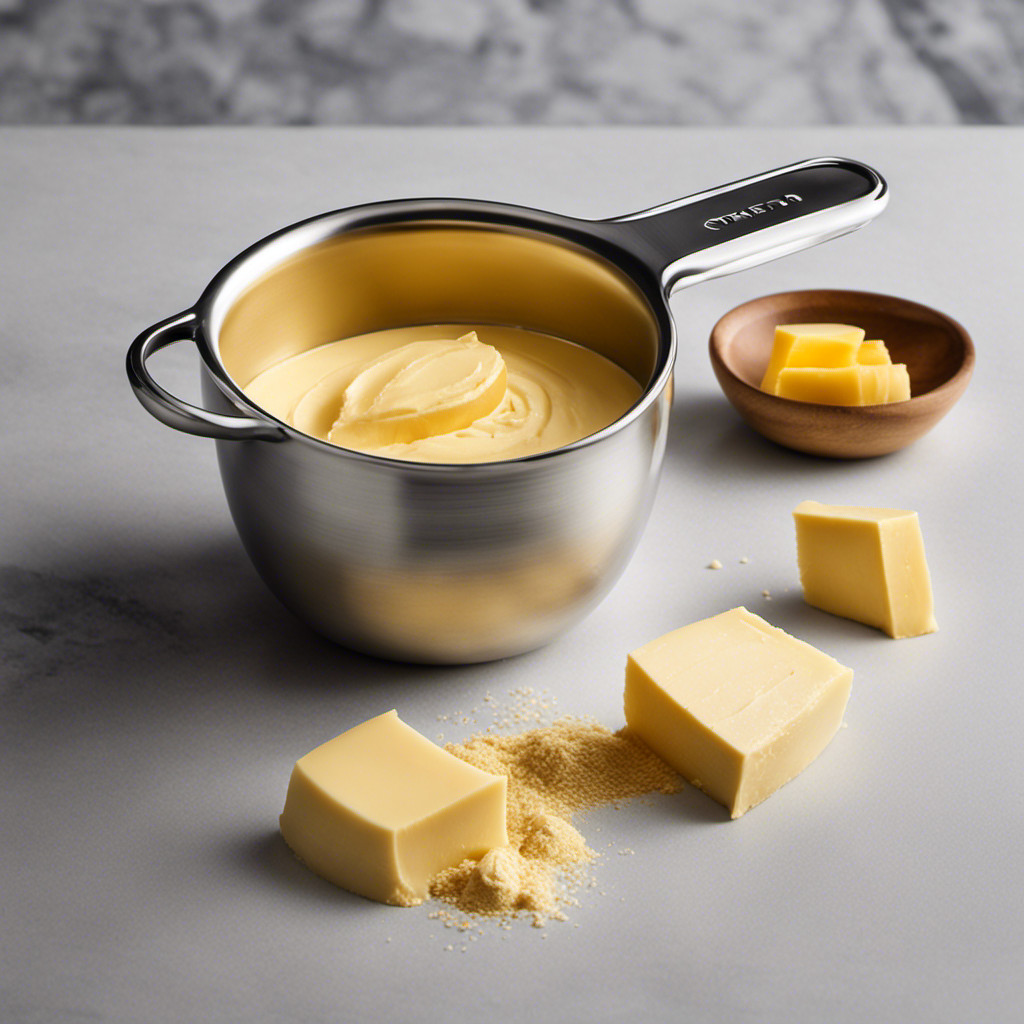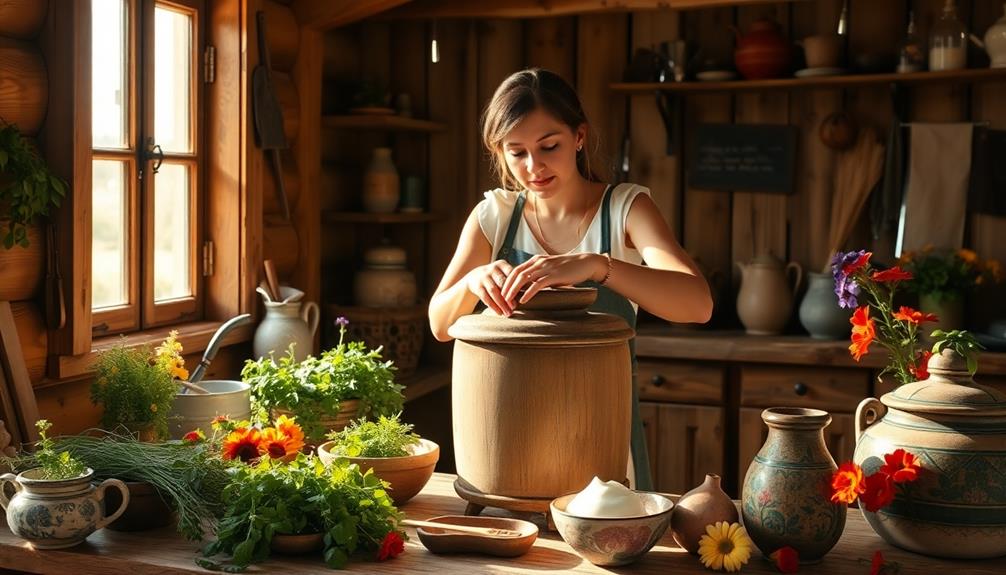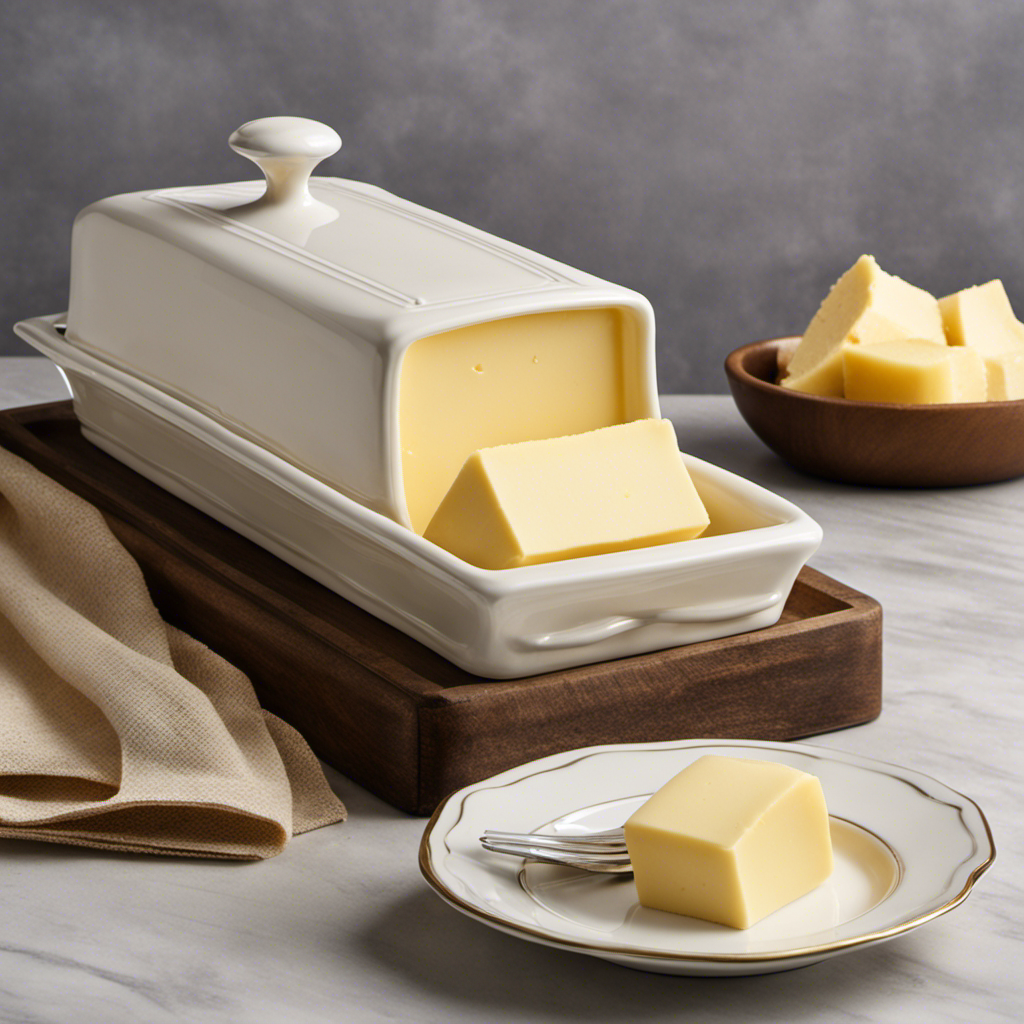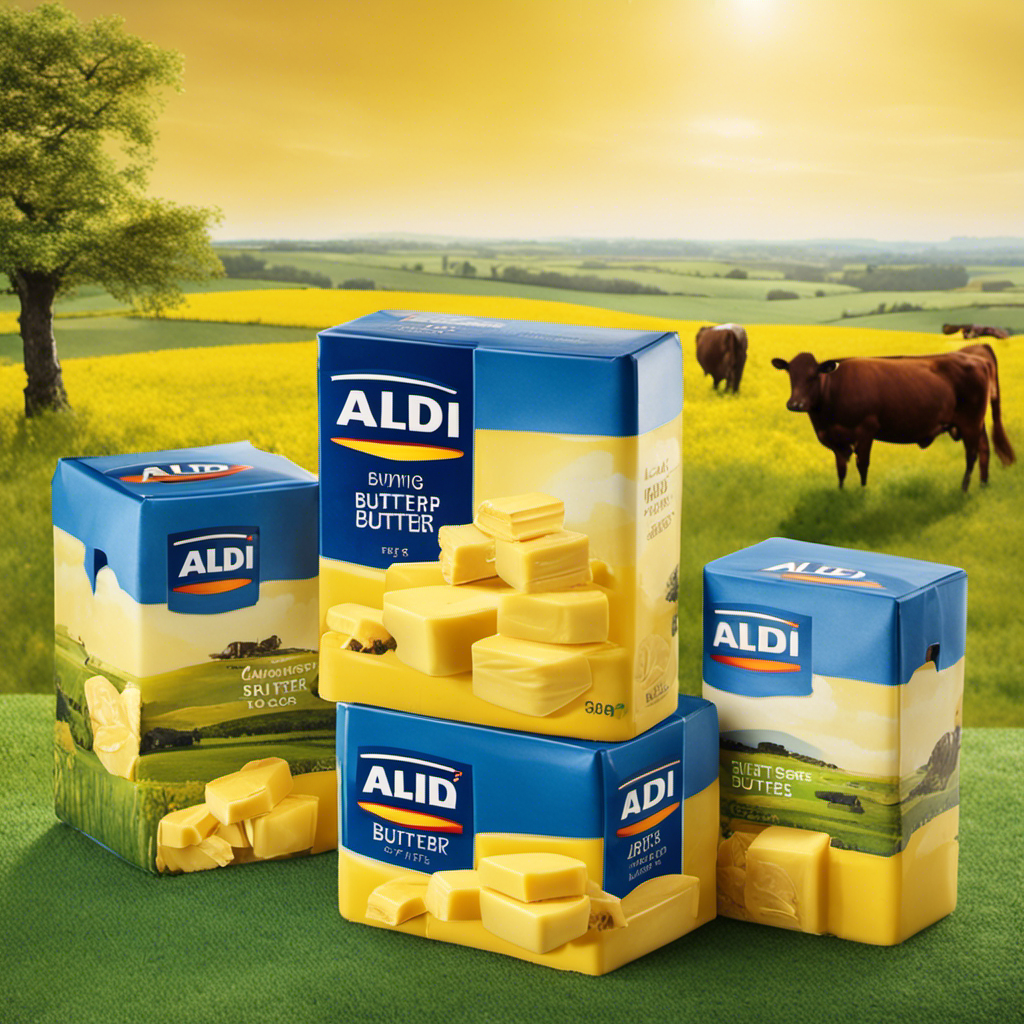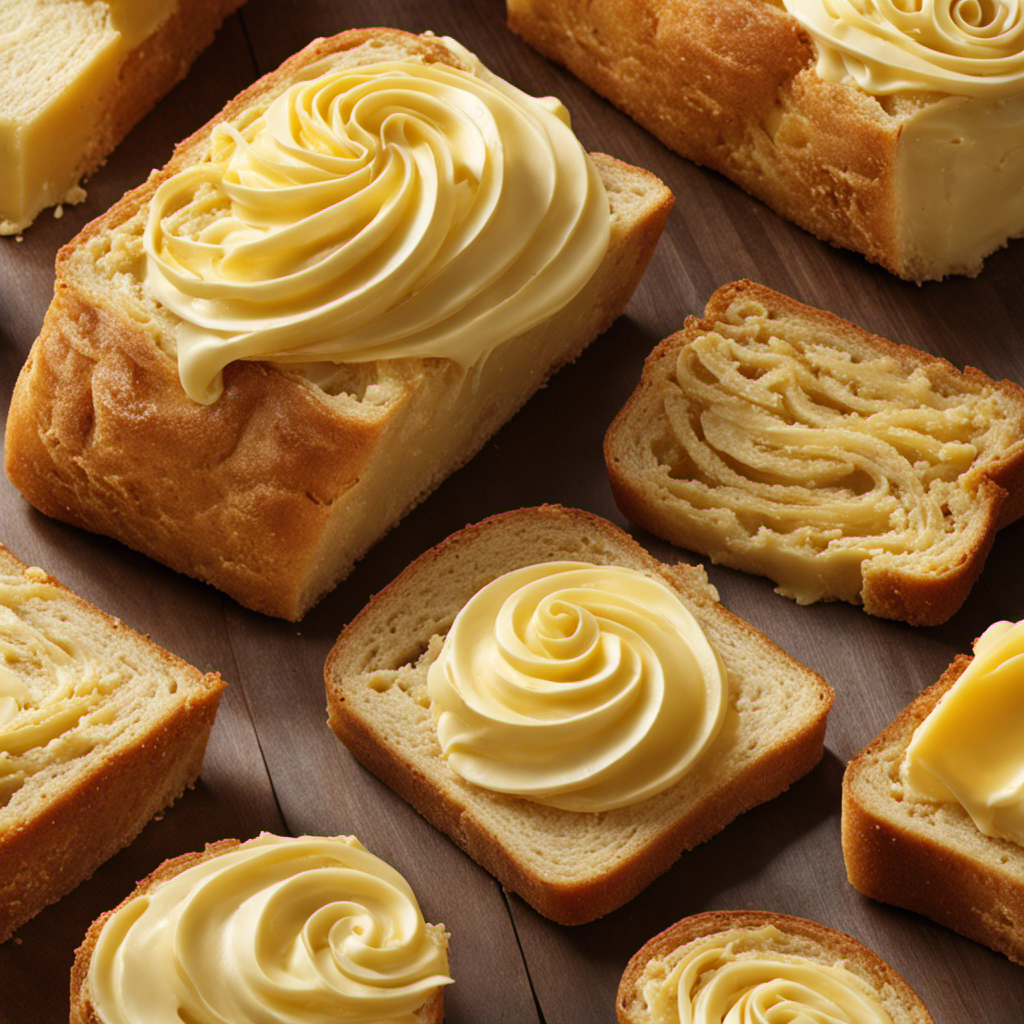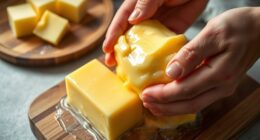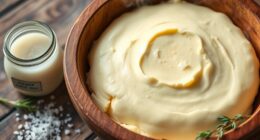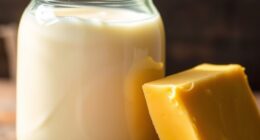Were you aware that adding 1/3 cup of butter could greatly enhance your dishes? As a culinary enthusiast and avid baker, I recognize the crucial role that precise measurements play.
In this article, I will guide you through the process of converting 1/3 cup of butter to tablespoons, grams, and even sticks. I will also share tips on adjusting recipes for different butter measurements and how to soften butter quickly.
Let’s dive in and master the art of measuring butter precisely.
Key Takeaways
- Understanding the density of butter is important for accurate measurements.
- 1/3 cup of butter is equal to 5 and 1/3 tablespoons or 2 and 2/3 sticks of butter.
- Accurate measurements are crucial for achieving the desired outcome in cooking.
- Butter substitutes like margarine, coconut oil, applesauce, mashed bananas, and Greek yogurt can be used in equal amounts as butter.
Understanding Measurement Conversions
Understanding measurement conversions can be tricky, but knowing how much is 1/3 cup of butter will make your cooking experience smoother.
The science behind accurate measurements lies in understanding the density of butter. Density refers to how much mass is packed into a given volume.
Butter, being a solid, has a specific density that allows us to convert between different measurements. In the case of 1/3 cup of butter, it means that you need to measure out a quantity of butter that occupies one-third of a standard cup.
This can be achieved by either using a measuring cup with clear markings or by cutting a stick of butter into equal thirds.
The Importance of Accurate Measurements
Accurate measurements are crucial when cooking to ensure the desired outcome. Without precise measurements, the taste and texture of a dish can be compromised.
To achieve accurate measurements, there are several techniques that can be employed:
-
Use a kitchen scale: This allows for precise measurements by weighing ingredients rather than relying on volume measurements.
-
Use measuring cups and spoons: These tools are essential for measuring dry and liquid ingredients accurately.
-
Level off ingredients: When measuring flour, sugar, or other dry ingredients, it is important to level off the top to ensure an accurate measurement.
In addition to measurement techniques, there are also butter substitutes available for those who prefer not to use butter in their cooking. These substitutes can be used in equal amounts as butter and can provide a similar taste and texture to the dish.
Butter Conversions: Cups to Grams
When it comes to baking, accurate measurements are crucial. Understanding how much butter is needed can make or break a recipe. In this discussion, we will explore the importance of accurate butter measurement. We will also delve into the process of converting cups to grams, ensuring that your baking endeavors are precise and successful.
Accurate Butter Measurement
You can easily measure 1/3 cup of butter by using a measuring cup and pressing the butter firmly into it. Here are some tips for accurate butter measurement:
- Make sure the butter is at room temperature before measuring.
- Use a dry measuring cup to ensure precise measurement.
- Level off the top of the butter with a straight edge, such as a knife, to remove any excess.
Accurate butter measurement is important for achieving consistent results in baking and cooking. Using the correct amount of butter is crucial for the texture and flavor of your dishes.
Now that you know how to measure 1/3 cup of butter accurately, let’s move on to converting cups to grams, which can be helpful for international recipes or when using a kitchen scale.
Converting Cups to Grams
Converting cups to grams can be helpful when following international recipes or using a kitchen scale. Understanding butter consistency is important for accurate measurements. To convert butter measurements accurately, it’s crucial to know that 1 cup of butter is equal to 227 grams.
This conversion is useful when you need to be precise in your baking or cooking. By knowing the weight in grams, you can easily measure the desired amount of butter using a kitchen scale.
Now, let’s move on to converting 1/3 cup of butter to tablespoons, which is another common conversion that can come in handy when following recipes or adjusting ingredient quantities.
Converting 1/3 Cup of Butter to Tablespoons
When it comes to working with butter in recipes, it’s important to have accurate measuring techniques.
One key conversion to know is how to convert 1/3 cup of butter to tablespoons.
This knowledge will help ensure that your recipes turn out just right and that you can easily adjust them if needed.
Butter Tablespoon Conversion
The conversion from 1/3 cup of butter to tablespoons is straightforward. To help you understand the butter measurement equivalents and butter conversion ratios, here are three key points:
- 1/3 cup of butter is equal to 5 and 1/3 tablespoons.
- To convert from cups to tablespoons, remember that 1 cup is equal to 16 tablespoons, so you can divide 1/3 by 16 to get the equivalent in tablespoons.
- Another way to think about it is to divide 1/3 by 3, which gives you 1/9. Then, multiply 1/9 by 3 to get 1/3, which is equal to 5 and 1/3 tablespoons.
Understanding these conversion ratios will help you accurately measure and convert butter from cups to tablespoons in your recipes.
Accurate Measuring Techniques
When it comes to measuring butter accurately, there are a few techniques that I find helpful.
One method is to use a kitchen scale. By weighing the butter, you can ensure precise measurements every time.
Another technique is to use the markings on the butter wrapper. Most butter sticks have markings indicating tablespoon measurements, making it easy to measure out the required amount.
Additionally, you can use a butter dish with measurement markings to scoop out the desired amount.
If you don’t have any of these tools, you can estimate by using the guidelines on the butter package. One stick of butter is typically equal to 1/2 cup or 8 tablespoons.
Adjusting Recipes With Butter
If you want to adjust a recipe, you can easily substitute butter with healthier alternatives like applesauce or mashed bananas. These alternatives not only reduce the fat content but also add a unique flavor to your dish. Here are three alternative ingredients you can use in place of butter:
-
Applesauce: Use equal parts of unsweetened applesauce to replace the butter. It works best in recipes like muffins and cakes.
-
Mashed bananas: Mashed ripe bananas can be used as a substitute for butter in recipes like pancakes and bread. Use 1/2 cup of mashed bananas for every 1 cup of butter.
-
Greek yogurt: Greek yogurt can be used to replace butter in recipes like cookies and brownies. Use 1/2 cup of Greek yogurt for every 1 cup of butter.
By using these alternative ingredients, you can make your recipes healthier without compromising on taste.
Now, let’s move on to the next section and learn about how many sticks of butter are in 1/3 cup.
How Many Sticks of Butter Is 1/3 Cup
There’s no denying that 1/3 cup of butter is equal to 5 and 1/3 tablespoons or 2 and 2/3 sticks of butter. When it comes to measuring butter, it’s important to have accurate equivalents to ensure the success of your recipes. To help you visualize the measurements, here’s a table that shows the butter measurement equivalents:
| Butter Measurement | Equivalent |
|---|---|
| 1/3 cup | 5 and 1/3 tablespoons or 2 and 2/3 sticks |
| 1 stick | 8 tablespoons or 1/2 cup |
| 1 tablespoon | 1/16 cup or 1/2 ounce |
| 1 cup | 2 sticks or 16 tablespoons |
If you’re looking for alternative ingredients for 1/3 cup of butter, you can try using margarine, vegetable oil, or applesauce as substitutes. These alternatives can help reduce the amount of saturated fat in your recipes while still providing the necessary moisture and flavor. Just keep in mind that the taste and texture of your dish may vary slightly depending on the substitute used.
Converting 1/3 Cup of Butter to Ounces
When it comes to butter measurement conversion, one common question is how many ounces are in 1/3 cup.
To calculate the quantity of butter needed, it is important to know the conversion factor between cups and ounces.
Butter Measurement Conversion
You can easily convert 1/3 cup of butter into grams by multiplying it by 76.
Here are some other helpful information about butter measurement conversion:
-
Butter alternatives: If you’re looking for a healthier option, you can substitute butter with alternatives like coconut oil, olive oil, or avocado. These alternatives can be used in the same measurements as butter in most recipes.
-
Butter storage methods: To keep butter fresh, it’s best to store it in an airtight container in the refrigerator. You can also freeze butter for longer storage, just make sure to wrap it tightly in plastic wrap or a freezer bag.
-
Measuring butter: When measuring butter, it’s important to note that 1/3 cup is equal to approximately 76 grams or 2.67 ounces. This conversion can be useful when following recipes that use different measurements.
Understanding the measurement conversions for butter can help you in the kitchen and ensure accurate results in your recipes.
Now, let’s move on to discussing the number of ounces in 1/3 cup of butter.
Ounces in 1/3 Cup
In the previous subtopic, we discussed the conversion of butter measurements. Now, let’s focus on understanding the number of ounces in 1/3 cup of butter. Accurately converting measurements is crucial in cooking and baking, as it ensures the desired outcome of our recipes.
To convert cups to ounces, we need to know the specific ingredient’s density. In the case of butter, the conversion is different, as it is not a liquid. Here is a helpful table to guide you in converting 1/3 cup of butter to ounces:
| Cups | Tablespoons | Ounces |
|---|---|---|
| 1/4 cup | 4 tablespoons | 2 ounces |
| 1/3 cup | 5 1/3 tablespoons | 2.67 ounces |
| 1/2 cup | 8 tablespoons | 4 ounces |
| 1 cup | 16 tablespoons | 8 ounces |
| 2 cups | 32 tablespoons | 16 ounces |
With this table, you can convert any butter measurement accurately. Remember, precise measurements are the key to culinary success!
Calculating Butter Quantity
To accurately calculate the quantity of butter needed for your recipe, it’s important to refer to the conversion table provided above. Estimating the amount of butter required can be tricky, but with a few simple calculations, you can get it right every time.
Here are a few steps to help you calculate the butter quantity:
- Determine the total amount of butter needed for the recipe.
- Convert the measurement to the desired unit, such as cups or grams.
- Use the butter ratio provided in the conversion table to calculate the amount of butter required.
Calculating butter ratios ensures that you use the correct amount of butter, resulting in a delicious and well-balanced dish. By following these steps, you can confidently estimate the quantity of butter needed for any recipe.
Butter Substitutes for 1/3 Cup Measurement
There’s a variety of butter substitutes available for measuring 1/3 cup. If you don’t have butter on hand or prefer a different option, these substitutes can work just as well in your recipes.
One common substitute is margarine, which has a similar texture and taste to butter. Another option is coconut oil, which can add a hint of coconut flavor to your dishes.
If you’re looking for a healthier alternative, you can try using applesauce or mashed bananas. These ingredients will add moisture and sweetness to your recipes.
When using butter substitutes, it’s important to consider their different melting points. To quicken the softening process, you can cut the substitute into small pieces or microwave it in short intervals, stirring in between.
Common Baking Recipes Using 1/3 Cup of Butter
For many baking recipes, a 1/3 cup of butter is a common ingredient. It adds richness and flavor to various treats, such as buttercream frosting and shortbread cookies.
Here are three popular recipes that call for 1/3 cup of butter:
-
Buttercream Frosting: Creamy and smooth, buttercream frosting is a staple for decorating cakes and cupcakes. With just a 1/3 cup of butter, you can create a luscious topping that complements any dessert.
-
Shortbread Cookies: The perfect combination of buttery goodness and crumbly texture, shortbread cookies are a classic treat. The 1/3 cup of butter ensures that these cookies have a rich, buttery flavor that melts in your mouth.
-
Pound Cake: Known for its dense and moist texture, pound cake relies on the richness of butter. The 1/3 cup of butter in this recipe adds a velvety smoothness that makes every bite irresistible.
Adjusting Recipes for Different Butter Measurements
When adjusting recipes for different measurements of butter, it’s important to consider how the change will affect the texture and flavor of the final dish. Measuring equivalents can be a helpful tool in determining how much butter to use when a recipe calls for a different measurement.
For example, if a recipe calls for 1/3 cup of butter and you only have sticks of butter, you can use the measuring equivalent of 1/3 cup to determine that you need 5 and 1/3 tablespoons of butter.
It’s also important to remember that there are butter alternatives available for those who may be looking for a healthier option or have dietary restrictions. These alternatives can provide similar results in terms of texture and flavor.
Tips for Measuring Butter Precisely
To measure butter precisely, it’s helpful to use a kitchen scale for accurate measurements. Estimating or eyeballing can lead to incorrect amounts, resulting in recipe mishaps. Here are some tips to ensure accurate butter measurements:
-
Use a kitchen scale: Weighing butter on a scale provides the most precise measurement, especially when dealing with small quantities.
-
Soften butter properly: Softened butter should be at room temperature, not melted. This ensures consistent measurements and helps achieve the desired texture in baked goods.
-
Be cautious with butter substitutes: Different butter substitutes have varying water content, which can affect the outcome of your recipe. Read the packaging carefully and adjust measurements accordingly.
Common errors in butter measurement include using the wrong measuring tool, such as a liquid measuring cup, which can lead to incorrect amounts. It’s important to follow these tips to achieve the best results in your cooking and baking endeavors.
Conversions for Different Butter Types: Salted Vs Unsalted
In my previous subtopic, I discussed tips for measuring butter precisely. Now, let’s delve into conversions for different types of butter: salted versus unsalted. It’s important to know the conversion equivalents when using different types of butter in recipes.
To help you easily convert between salted and unsalted butter, here is a handy butter conversion chart:
| Salted Butter | Unsalted Butter |
|---|---|
| 1 cup | 1 cup + 1/4 tsp |
| 1/2 cup | 1/2 cup + 1/8 tsp |
| 1/4 cup | 1/4 cup + 1/16 tsp |
With this chart, you can easily adjust your butter measurements depending on the type you have on hand. It ensures that your recipes turn out just right, whether you prefer salted or unsalted butter. Happy baking!
How to Soften 1/3 Cup of Butter Quickly
You can quickly soften 1/3 cup of butter by using the microwave method. Here’s how:
- Place the butter in a microwave-safe bowl.
- Heat the butter in the microwave on low power for 10-second intervals.
- Check the butter after each interval to see if it has softened to your desired consistency.
Using this method, you can have soft and spreadable butter in no time. It’s a convenient way to quickly melt butter when you don’t have the time to wait for it to soften at room temperature.
Remember to use caution when handling the bowl, as it may become hot from the microwave. Additionally, if you don’t have a measuring cup that specifically measures 1/3 cup, you can use alternative butter measurements such as 5 1/3 tablespoons or 11 tablespoons plus 1 teaspoon.
Frequently Asked Questions
Can I Use Margarine Instead of Butter in a Recipe That Calls for 1/3 Cup of Butter?
Sure, you can use margarine instead of butter in a recipe that calls for 1/3 cup of butter. However, keep in mind that there may be nutritional differences between the two. For baking, make sure to use a margarine that has a similar fat content to butter.
How Can I Accurately Measure 1/3 Cup of Butter Without a Measuring Cup?
To accurately measure 1/3 cup of butter without a measuring cup, you can use measuring spoons. One tablespoon is equal to 1/16 cup, so you would need 5 tablespoons of butter.
Are There Any Vegan Substitutes for Butter in Recipes That Require 1/3 Cup?
There are many vegan butter substitutes available for recipes that require 1/3 cup of butter. Plant-based alternatives like coconut oil, avocado, or nut butters can be used as a delicious and cruelty-free option.
Can I Use Coconut Oil Instead of Butter in a Recipe That Calls for 1/3 Cup?
Sure, you can use coconut oil instead of butter in a recipe that calls for 1/3 cup. It’s a vegan substitute and has health benefits like boosting metabolism. Just make sure to use the same amount.
What Is the Calorie Content of 1/3 Cup of Butter?
The calorie content of 1/3 cup of butter is approximately 716 calories. While butter is high in calories, it does have health benefits when used in moderation, such as providing essential vitamins and healthy fats.
Conclusion
In conclusion, measuring ingredients accurately is crucial for successful baking and cooking. Understanding measurement conversions, such as converting 1/3 cup of butter to tablespoons or grams, allows for precise calculations. Adjusting recipes for different butter measurements ensures consistent results.
To soften 1/3 cup of butter quickly, follow the recommended techniques. Whether using salted or unsalted butter, conversions should be made accordingly.
By following these tips and techniques, you can confidently create delicious dishes with the perfect amount of butter.

